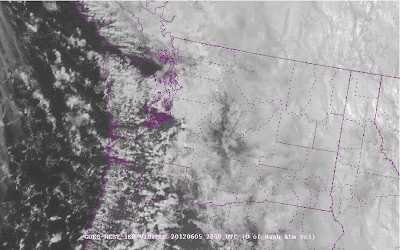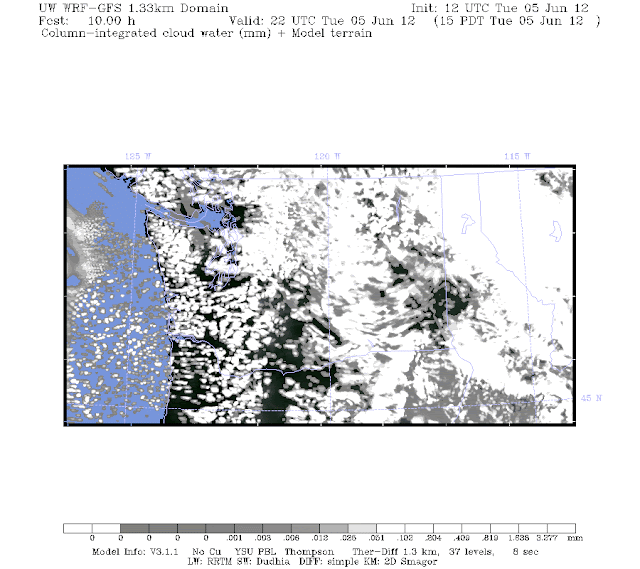Yesterday I told people who wanted to view the transit of Venus along the coast to go as close to the water as possible...why?
There is often a major difference between the amount of clouds offshore or right on the coast and just a short distance inland, with clouds increasing inland--so being right on the coast really increased the chances of seeing the transit of Venus yesterday.
Here is an example of the effect. First, a visible satellite picture from the GOES satellite at 3 PM yesterday (about when the transit started!). There was some clouds and convective showers offshore, but look what happens as the air crosses the coast...you can see lines of small cumulus developing, aligned in cloud "streets" parallel to the winds. You can also view the convergence zone over Puget Sound and the enhanced clear zones to the north and south...many of you wisely headed there.
We can get a better view of the development of coastal clouds from another satellite: the polar-orbiting MODIS system. Here are two pictures from it, with horizontal resolutions of 250 meters. The first image is along and east of the central WA coat and the second southern Vancouver Is. You can really see the effect in this images...relatively cloud free offshore and on the immediate coas,t with clouds developing inland. You notice that some of the clouds even get bigger inland.
High-resolution weather forecasting models, like the UW WRF model run at 1.33 km grid spacing, can produce this observed cloud distribution. Here is a sample from yesterday
for a forecast valid at 3 PM. Not bad...and it also got the convergence zone clouds and the clear zones to the north and south.
So why do clouds form just inland along the coast, particularly during the day (this phenomenon is far less prevalent at night).
This time of the year the sun is quite strong and is able to heat up the land substantially when a solid overcast is not overhead. The water offshore is cool (roughly 50F). When cool air moves over the warm land, we have a large change of temperature with height. Such large vertical temperature changes can cause the air to convect, producing upward thermals and cumulus clouds. This is quite similar to what happens in your saucepan when you turn on the burner...a large change in temperature with height causes your cereal to convect.
This convection takes a time to develop, so there it is a mile or so inland before clouds start forming in a significant way.
The development of coastal clouds is also helped along by what is called coastal frictional convergence. This is the kind of terminology that will impress your friends and fascinate folks at cocktail parties. The ocean surface is aerodynamically relatively smooth (little friction) and thus winds over water are strong. Over land the surface is far rougher and that slows down the winds.
So if air is moving inland (eastward)....fast moving air from the ocean meets air that is moving more slowly over land. Air get piled up and some of the air is forced to rise...this is the coastal convergence. Rising air produces clouds.
Finally, in many parts of the Pacific coast there is terrain just inland, terrain that causes air to rise...and yes....forming clouds.
So for a number of reasons, expect more clouds as one moves inland from the shore. Another reason that hotels on the coast can charge more than their brethren a few miles inland.
Home
»
»Unlabelled
» Coastal Clouds
Thứ Tư, 6 tháng 6, 2012
Đăng ký:
Đăng Nhận xét (Atom)
Bài đăng phổ biến
-
Koharu Nishino is a japanese gravure idol born in Saitama on 5 7 1989. Her blood type is B, and she is 155 cm tall, Koharu's body measur...
-
Kana Ito is a japanese gravure idol born in Fukuoka on 28 7 1984. Her blood type is A, and she is 161 cm tall, Kana's body measurements ...
-
Profile Elly Tran Ha Real Name : Tran Kim Hong Date of Birth: 6/8/1987 Height: 168 cm Measurements: 88-58-90 cm Place of Birth: Viet Nam Na...
-
Five Vi Rahmawati Profile: Name: Five Vi Rahmawati Birthday:December 12, 1979 Gender: Female Religion: Islam Born: Surabaya Five Vi Rahmawa...
-
There has been a lot of press coverage of late about the successful commercial space venture Space-X. This private sector effort was able ...
-
The media mentions it frequently and global warming skeptics talk of little else: the fact that global atmospheric temperatures have not go...
-
Cô giáo Thảo-Mai Nishida tại trường học Mai Nishida khiêu dâm tại trường
-
This morning I didn't plan on biking home in strong winds, rumbling thunder, light rain and a blocked bike trail....but it happened. Du...
-
Tsubasa Nagumo is a japanese gravure idol born in Kanagawa on 10 3 1988. Her blood type is O, and she is 160 cm tall, Tsubasa's body mea...
-
Tsubasa Akimoto is a japanese gravure idol born in Tokyo on 11 11 1991. Her blood type is A, and she is 163 cm tall, Tsubasa's body meas...
















0 nhận xét:
Đăng nhận xét